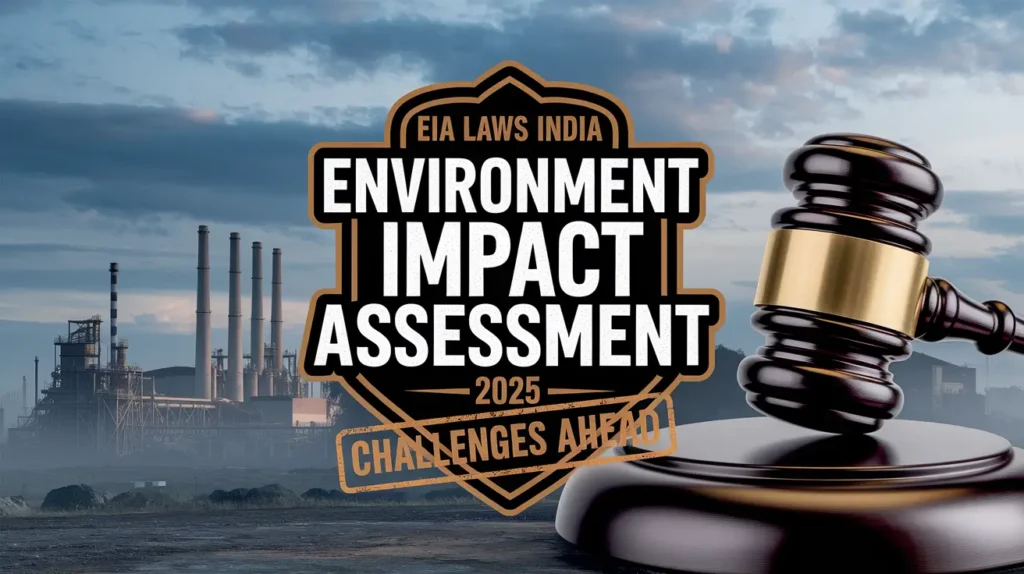Environmental Impact Assessment Laws in India: Challenges Ahead highlight the critical role of EIA in balancing development and sustainability. Governed by the Environment Protection Act, 1986, these laws face challenges like weak enforcement, diluted public participation, and the controversial 2020 EIA draft. This blog explores the legal framework, recent trends in 2025, and key hurdles for legal aspirants.
Table of Contents
Introduction
Environmental Impact Assessment Laws in India: Challenges Ahead have become a pressing concern as the country navigates the delicate balance between rapid development and environmental sustainability. Environmental Impact Assessment (EIA) is a critical tool designed to evaluate the potential environmental consequences of proposed projects, ensuring sustainable development while minimizing ecological harm. In India, EIA laws are primarily governed by the Environment Protection Act, 1986, and the EIA Notification of 1994, which has undergone multiple amendments, including the controversial 2020 draft.
As of March 22, 2025, the implementation of these laws faces significant hurdles, including weak enforcement, diluted public participation, and judicial scrutiny, all of which threaten their effectiveness. For legal aspirants preparing for Judiciary, APO, and JLO exams, understanding the intricacies of EIA laws is crucial, as they intersect with environmental law, constitutional rights, and current legal trends. This blog delves into the historical evolution of EIA laws in India, their legal framework, key challenges, recent developments in 2025, and recommendations for the future, offering a comprehensive guide for aspirants and stakeholders alike.
1. Understanding Environmental Impact Assessment Laws in India
Environmental Impact Assessment (EIA) is a systematic process to evaluate the environmental, social, and economic impacts of a proposed project before it is approved, ensuring that development aligns with sustainability goals.
- Definition: EIA is a decision-making tool that predicts the environmental effects of a project, proposes mitigation measures, and offers alternatives to decision-makers, aiming to reduce adverse impacts while promoting sustainable development.
- Objective: The primary goal of EIA laws in India is to ensure optimal use of natural resources, minimize environmental degradation, and promote community participation in decision-making, as emphasized by the United Nations Environment Programme (UNEP).
- Scope: In India, EIA is mandatory for 40 categories of developmental activities, including mining, oil and gas exploration, nuclear power, and township development, provided the investment exceeds INR 500 million, as per the EIA Notification, 2006.
- Process: The EIA process involves four stages: screening (identifying projects requiring assessment), scoping (determining the extent of the study), public consultation (involving stakeholders), and appraisal (evaluating the EIA report for clearance).
The Environmental Impact Assessment Laws in India: Challenges Ahead underscore the need to strengthen this framework to address emerging environmental threats effectively.
2. Historical Evolution of EIA Laws in India
The journey of EIA laws in India reflects the country’s growing recognition of environmental concerns amidst rapid industrialization.
- Early Beginnings (1970s): The Indian experience with EIA began in 1976-77 when the Planning Commission tasked the Department of Science and Technology with examining river-valley projects from an environmental perspective. This was later extended to projects requiring Public Investment Board approval.
- Formalization (1994): Until 1994, environmental clearances were administrative decisions without legislative backing. On January 27, 1994, the Ministry of Environment and Forests (MoEF) issued the EIA Notification under the Environment Protection Act, 1986, making environmental clearance mandatory for specified projects, marking a significant step toward formalizing EIA laws.
- Amendments and Evolution: The EIA Notification of 1994 has seen 12 amendments, with the 2006 Notification being a key overhaul that streamlined the process and introduced public consultation as a mandatory step. However, the 2020 draft EIA Notification sparked controversy, as it proposed measures like ex post facto clearances, which were deemed illegal by the Supreme Court in cases like Alembic Pharmaceuticals Ltd v. Rohit Prajapati (2020).
- Judicial Oversight: The judiciary has played a pivotal role in shaping EIA laws, with cases like M.C. Mehta v. Union of India (1986) advocating for specialized environmental courts, leading to the establishment of the National Green Tribunal (NGT) in 2010.
This historical context sets the stage for understanding the Environmental Impact Assessment Laws in India: Challenges Ahead, as past reforms reveal persistent gaps in implementation and enforcement.
3. Legal Framework Governing EIA Laws in India
The Environmental Impact Assessment Laws in India: Challenges Ahead are rooted in a legal framework designed to balance development with environmental protection, but its effectiveness is often questioned.
- Environment Protection Act, 1986: The EPA provides the statutory backing for EIA in India, empowering the central government to regulate activities that impact the environment. Section 3 of the EPA authorizes the issuance of notifications like the EIA Notification.
- EIA Notification, 2006: This notification, amended multiple times, mandates EIA for specified projects, outlining the process of screening, scoping, public consultation, and appraisal. It requires environmental clearance for 40 categories of projects, such as mining and thermal power plants, with investments above INR 500 million.
- Role of Regulatory Bodies: The Central Pollution Control Board (CPCB) and State Pollution Control Boards (SPCBs) oversee enforcement, conducting inspections, ensuring compliance through periodic reporting, and imposing penalties for violations. The State Environment Impact Assessment Authority (SEIAA) appraises projects at the state level.
- Judicial Oversight: The Supreme Court, High Courts, and NGT play a significant role in enforcing EIA laws. The NGT, established in 2010, has taken suo motu cognizance of environmental violations, while the Supreme Court has simplified locus standi for environmental public interest litigation (PIL), enabling broader access to justice.
- International Influence: The Rio Declaration (1992) emphasized EIA as a national instrument for projects with adverse environmental impacts, influencing India’s adoption of international standards like public participation and sustainable development.
This legal framework, while robust on paper, faces significant challenges, as explored in the Environmental Impact Assessment Laws in India: Challenges Ahead.
4. Key Impacts of EIA Laws in India
EIA laws in India have had a transformative impact on environmental governance, but their implementation reveals both strengths and weaknesses.
- Promoting Sustainable Development: EIA laws ensure that projects align with sustainable development goals by identifying and mitigating environmental impacts early in the planning cycle, as seen in cases like Residents Welfare Association v. UT of Chandigarh (2024), where the Supreme Court mandated EIAs for urban development to prevent ecological damage.
- Community Participation: The public consultation stage empowers communities to voice concerns, fostering participatory justice. In Samarth Trust v. Union of India (2017), the Delhi High Court recognized public participation as a cornerstone of EIA, giving a voice to the voiceless.
- Regulatory Oversight: EIAs enable regulators like the CPCB and SPCBs to monitor compliance, ensuring that industries adhere to environmental norms. For instance, the NGT’s 2024 directive for SEIAA to reappraise district-level environmental clearances (ECs) reflects efforts to strengthen oversight.
- Judicial Accountability: The judiciary has used EIA laws to hold violators accountable. In Alembic Pharmaceuticals Ltd v. Rohit Prajapati (2020), the Supreme Court struck down ex post facto clearances, reinforcing the need for prior environmental assessment to prevent irreparable harm.
These impacts highlight the potential of Environmental Impact Assessment Laws in India: Challenges Ahead, but systemic issues continue to undermine their effectiveness.
5. Recent Trends in EIA Laws in 2025
As of March 22, 2025, the Environmental Impact Assessment Laws in India: Challenges Ahead are shaped by recent developments that reflect both progress and setbacks:
- Judicial Interventions: In 2024, the NGT directed that environmental clearances granted by District Environment Impact Assessment Authorities (DEIAAs) be reappraised by SEIAA, following the case of Noble M Paikada v. Union of India. This decision addressed inconsistencies in the 2016 amendments to the EIA Notification, which allowed DEIAAs to grant ECs for small-scale mining without public consultation, deemed violative of Supreme Court mandates.
- Digital Integration: The adoption of digital tools has streamlined the EIA process, with e-filing and virtual hearings becoming common. A 2025 Law Ministry report noted a 10% increase in EIA case disposals due to digitalization, though challenges like poor connectivity in rural areas persist.
- Focus on Compliance: The NGT and Supreme Court have emphasized stricter compliance. In 2024, the Supreme Court in MC Mehta v. Union of India directed NCR states to fill vacancies in SPCBs by April 30, 2025, to improve enforcement, noting that vacant posts had rendered SPCBs ineffective in tackling issues like stubble burning.
- Debate on GMOs: A 2024 split decision by the Supreme Court in a case challenging the environmental release of genetically modified mustard (Justice BV Nagarathna and Justice Sanjay Karol) highlighted the need for robust EIA processes to assess the environmental impact of GMOs, raising concerns about inadequate regulatory frameworks.
- Public Sentiment: Posts on X reflect growing public concern over EIA laws, with some users praising judicial efforts to strengthen oversight, while others criticize the government for prioritizing development over environmental protection, though these sentiments remain inconclusive.
These trends underscore the evolving nature of Environmental Impact Assessment Laws in India: Challenges Ahead, as they adapt to modern demands while grappling with systemic issues.
6. Challenges Facing Environment Impact Assessment Laws in India
The Environmental Impact Assessment Laws in India: Challenges Ahead are hindered by several systemic and procedural issues:
- Weak Enforcement and Compliance: Despite legal mandates, enforcement remains a major challenge. Many projects proceed without proper EIAs, and violations often go unpunished due to inadequate monitoring by SPCBs. The Supreme Court’s 2024 directive in MC Mehta v. Union of India highlighted the inefficacy of SPCBs due to staffing shortages, with 60% of posts vacant in some states.
- Dilution of Public Participation: The 2020 draft EIA Notification proposed exemptions for several industries, including chemical manufacturing and large-scale renewable energy projects, from public hearings, undermining participatory justice. The Supreme Court in Alembic Pharmaceuticals Ltd v. Rohit Prajapati (2020) condemned post facto clearances, noting that they exclude meaningful public input, as impacts may already have occurred.
- Ex Post Facto Clearances: The 2020 draft’s provision for ex post facto clearances, allowing projects to proceed without prior EIA subject to fines, has been widely criticized. The Supreme Court in 2020 ruled such clearances illegal, calling them an “anathema” to environmental jurisprudence, as they prioritize development over ecological protection.
- Inadequate Study Scope: The 2020 draft defines the study area for EIAs as 5 km around a project, regardless of site-specific impacts. For instance, river valley projects often have wider ecological impacts, and this narrow definition limits the effectiveness of assessments, as noted in environmental critiques.
- Judicial and Regulatory Overlap: While the judiciary has been proactive, overlapping roles between the NGT, CPCB, and SPCBs lead to delays and inconsistencies. The NGT’s limited resources—operating with only 4 judicial and 2 expert members against a mandated 10 each as of 2019—further exacerbate delays in EIA-related cases.
- Lack of Transparency: The review process for the 2020 draft was criticized for lacking transparency, with limited public access to discussions, raising concerns about government intent to favor industrial interests over environmental protection.
These challenges highlight the urgent need to address the Environmental Impact Assessment Laws in India: Challenges Ahead to ensure they fulfill their intended purpose.
7. Recommendations for Strengthening EIA Laws
To address the Environmental Impact Assessment Laws in India: Challenges Ahead, the following measures are recommended:
- Strengthen Enforcement Mechanisms: Increase staffing and funding for SPCBs and the NGT, ensuring they can effectively monitor and enforce EIA compliance. The Supreme Court’s 2024 directive to fill SPCB vacancies by April 2025 should be implemented urgently.
- Enhance Public Participation: Mandate public consultation for all projects, regardless of sector, and ensure that hearings are conducted before project implementation, aligning with the Supreme Court’s stance against post facto clearances.
- Revise the 2020 Draft: Scrap provisions for ex post facto clearances and expand the study area definition to account for site-specific impacts, ensuring comprehensive EIAs that protect vulnerable ecosystems.
- Leverage Technology: Expand digital tools for transparency and efficiency, such as online tracking of EIA applications and virtual public hearings, while addressing connectivity issues in rural areas to ensure inclusivity.
- Promote Transparency: Make the EIA amendment process more accountable by involving stakeholders, including environmentalists and local communities, in drafting and reviewing notifications, as suggested by posts on X calling for greater public involvement.
- Integrate Climate Considerations: Update EIA laws to include climate change impacts, such as carbon emissions and adaptation measures, aligning with India’s commitments under the Paris Agreement (2015).
These recommendations can help mitigate the Environmental Impact Assessment Laws in India: Challenges Ahead, ensuring they effectively balance development and environmental protection.
8. Significance for Legal Aspirants in 2025
For Judiciary, APO, and JLO exam candidates, understanding the Environmental Impact Assessment Laws in India: Challenges Ahead is crucial:
- Environmental Law Questions: EIA laws tie into the Environment Protection Act, 1986, and the NGT Act, 2010, often tested through cases like Alembic Pharmaceuticals Ltd v. Rohit Prajapati (2020) and Samarth Trust v. Union of India (2017). Aspirants must analyze the legal framework and judicial interpretations.
- Constitutional Law Application: The linkage of EIA to Article 21’s right to a healthy environment makes it relevant for constitutional law questions, particularly on public interest litigation and judicial activism.
- Current Affairs Relevance: Recent developments, such as the 2024 NGT directive on DEIAAs and the Supreme Court’s 2024 GMO ruling, make EIA laws a hot topic for current affairs sections in exams.
- Essay and Interview Preparation: The ethical and legal implications of EIA laws—balancing development with environmental justice—are frequent essay and interview topics, requiring a nuanced understanding of their challenges and solutions.
Mastering the Environmental Impact Assessment Laws in India: Challenges Ahead equips aspirants to tackle complex questions, ensuring they are well-prepared for competitive exams in 2025.
9. The Future of EIA Laws in India
Looking ahead, the Environmental Impact Assessment Laws in India: Challenges Ahead will require significant reforms to remain effective:
- Technological Integration: Continued adoption of digital tools, such as AI for EIA data analysis and virtual hearings, will improve efficiency and transparency, as seen in the 2025 digitalization trend.
- Stricter Compliance: Addressing staffing shortages in SPCBs and the NGT will enhance enforcement, potentially reducing the 60% non-compliance rate noted in 2024 reports.
- Climate-Focused EIAs: Future amendments may integrate climate change considerations, such as assessing carbon footprints and adaptation measures, aligning with global trends toward climate-conscious governance.
- Public Empowerment: Strengthening public participation through mandatory consultations and transparent processes will ensure that EIA laws uphold environmental democracy, as emphasized by the judiciary.
The future of EIA laws in India depends on addressing these challenges, ensuring they remain a robust tool for sustainable development in a rapidly changing world.
Conclusion
The Environmental Impact Assessment Laws in India: Challenges Ahead highlight the critical role of EIA in safeguarding the environment amidst India’s developmental ambitions. Rooted in the Environment Protection Act, 1986, and the EIA Notification of 1994, these laws aim to balance growth with sustainability, but face significant hurdles, including weak enforcement, diluted public participation, and controversial amendments like the 2020 draft. Recent trends in 2025, such as judicial interventions, digital integration, and focus on compliance, reflect efforts to address these issues, yet systemic challenges persist.
For legal aspirants, understanding this topic is essential for excelling in Judiciary exams, as it ties into environmental law, constitutional rights, and current affairs. Moving forward, strengthening enforcement, enhancing public involvement, and integrating climate considerations will be key to ensuring that Environmental Impact Assessment Laws in India: Challenges Ahead are met with effective solutions, paving the way for a sustainable future.
Want to master the Environmental Impact Assessment Laws in India: Challenges Ahead for your Judiciary, APO, or JLO exams? Join Doon Law Mentor’s Courses for expert guidance and comprehensive study materials! Follow @doonlawmentor on Instagram for the latest updates on environmental law and exam tips!
FAQs
- What are Environmental Impact Assessment (EIA) laws in India?
EIA laws in India, governed by the Environment Protection Act, 1986, mandate the assessment of environmental impacts of proposed projects to ensure sustainable development, covering sectors like mining and nuclear power. - What is the legal framework for EIA laws in India?
The framework includes the Environment Protection Act, 1986, the EIA Notification of 2006, and oversight by bodies like the CPCB, SPCBs, and NGT, with judicial review by the Supreme Court and High Courts. - What are the main challenges facing EIA laws in India?
Challenges include weak enforcement, diluted public participation, ex post facto clearances, inadequate study scope, judicial-regulatory overlap, and lack of transparency, as seen in the 2020 draft EIA Notification. - How has the judiciary shaped EIA laws in India?
The judiciary has enforced stricter compliance, as in Alembic Pharmaceuticals Ltd v. Rohit Prajapati (2020), and emphasized public participation, as in Samarth Trust v. Union of India (2017), strengthening EIA laws. - What recent trends in 2025 affect EIA laws in India?
Trends include judicial directives like the 2024 NGT ruling on DEIAAs, digital integration in the EIA process, focus on compliance, and debates over GMOs, reflecting evolving enforcement mechanisms. - How can EIA laws in India be strengthened?
By enhancing enforcement, mandating public consultation, revising the 2020 draft, leveraging technology, promoting transparency, and integrating climate change considerations into the EIA process. - Why are EIA laws important for sustainable development?
EIA laws ensure that projects minimize environmental harm, promote resource efficiency, and involve community input, aligning development with sustainability goals, as emphasized in Residents Welfare Association v. UT of Chandigarh (2024). - What is the controversy surrounding the 2020 EIA draft?
The 2020 draft proposed ex post facto clearances and exemptions from public hearings, criticized for undermining environmental protection and ruled illegal by the Supreme Court in 2020. - Why are EIA laws relevant for legal aspirants?
They are a key topic in environmental and constitutional law for Judiciary exams, covering the EPA, landmark cases, and current trends like the 2024 NGT directive on environmental clearances. - What is the future of EIA laws in India?
The future involves technological integration, stricter compliance, climate-focused EIAs, and enhanced public participation, ensuring that EIA laws effectively balance development and environmental protection.
#EIA2025, #EnvironmentalLawsIndia, #SustainableDevelopment, #IndiaLaw2025, #JudiciaryExams #environmentpollution #doonlawmentor #bestonlinejudiciarycoaching #bestapocoaching








